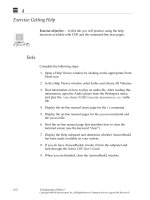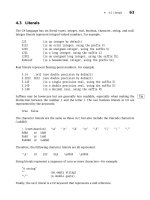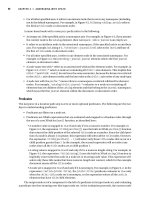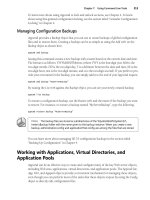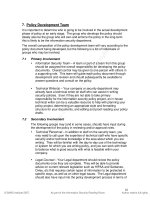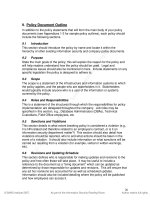information security policy development guide large small companies phần 4 potx
Bạn đang xem bản rút gọn của tài liệu. Xem và tải ngay bản đầy đủ của tài liệu tại đây (354.84 KB, 13 trang )
© SANS Institute 200 7, Author retains full rights.
Key fingerprint = AF19 FA27 2F94 998D FDB5 DE3D F8B5 06E4 A169 4E46
© SANS Institute 2007, As part of the Information Security Reading Room Author retains full rights.
26
9. Policy Document Outline
In addition to the policy statements that will form the main body of your policy
documents (see Appendices 1-2 for sample policy outlines), each policy should
include the following sections.
9.1 Introduction
This section should introduce the policy by name and locate it within the
hierarchy of other existing information security and company policy documents.
9.2 Purpose
State the main goals of the policy; this will explain the reason for the policy and
will help readers understand how the policy should be used. Legal and
compliance issues should also be mentioned in here. Include statements on any
specific legislation the policy is designed to adhere to.
9.3 Scope
The scope is a statement of the infrastructure and information systems to which
the policy applies, and the people who are stakeholders in it. Stakeholders
would typically include anyone who is a user of the information or systems
covered by the policy.
9.4 Roles and Responsibilities
This is a statement of the structures through which the responsibilities for policy
implementation are delegated throughout the company. Job roles may be
specified in this section, e.g., Database Administrators (DBAs), Technical
Custodians, Field Office employees, etc.
9.5 Sanctions and Violations
This section details to what extent breaking policy is considered a violation (e.g.,
it is HR-related and therefore related to an employee’s contract, or is it an
information security department matter?) This section should also detail how
violations should be reported, who to and what actions should be taken in the
event of a violation. It should also include information on what sanctions will be
carried out resulting from a violation (for example, verbal or written warnings,
etc).
9.6 Revisions and Updating Schedule
This section defines who is responsible for making updates and revisions to the
policy and how often these will take place. It may be useful to include a
reference to the document as a “living document” which can be updated as
determined by those responsible for updates and revisions. This will ensure that
any ad hoc revisions are accounted for as well as scheduled updates.
Information should also be included detailing where the policy will be published
and how employees can access it.
© SANS Institute 200 7, Author retains full rights.
Key fingerprint = AF19 FA27 2F94 998D FDB5 DE3D F8B5 06E4 A169 4E46
© SANS Institute 2007, As part of the Information Security Reading Room Author retains full rights.
27
9.7 Contact information
Detail who should be contacted in connection with policy. A group or mailbox
rather than an individual is preferable here as these are less likely to change.
9.8 Definitions/Glossary
Define any terms that may be unfamiliar to the reader. The necessity for this will
depend on the audience, e.g., the readership of a Technical Policy for Linux are
likely to already be familiar with the Linux technical terms, therefore it will not be
necessary to spell these out. The cryptography section of the user policy
however may include terms with which readers are not familiar and these should
be defined in footnotes or a glossary to aid comprehension.
9.9 Acronyms
A separate section spelling out acronyms may be required where there are a
large number or where the document is long or complex. For shorter documents,
acronyms may instead be spelt out in the body of the document.
© SANS Institute 200 7, Author retains full rights.
Key fingerprint = AF19 FA27 2F94 998D FDB5 DE3D F8B5 06E4 A169 4E46
© SANS Institute 2007, As part of the Information Security Reading Room Author retains full rights.
28
10. Troubleshooting
This section details some of the things that go wrong during policy development
and some ideas to remedy these problems.
10.1 Policies Lack Weight
It is a big concern when policies that have taken time and effort to develop are
not taken seriously. This is common when starting to develop information
security policies and for those whose development process isn’t yet mature.
Don’t worry too much at these early stages. Weight is likely to come with time
and increasing numbers of policies, backed up and promoted by a combination of
management backing and a good awareness/communication campaign. With
this will come a realisation on the part of the enterprise (and particularly those
bodies involved in compliance and governance) that policy can be used to
leverage change and a move towards best practice and compliance.
10.2 Lack of Reviewing Feedback
Lack of feedback following reviews can also be a fairly common complaint from
the policy development team. This is fine if the reviewers have read the policy
and simply don’t have any feedback; the problem arises when they have
skimmed over the document without reading it closely or taking in the implication
of its content. In these cases problems may only be noticed at a much later
stage or, even worse, after publication. This can serve to weaken the policy and
even discredit the policy development process as a whole.
One solution is to review each document in detail at a meeting (or meetings) with
each group of reviewer. The development team representative can read through
each policy statement and seek feedback on each one. This will help make sure
the reviewers have both read and thought about the policy in detail.
Sometimes reviewers may not be sure what is required of them and this may
result in a low level of feedback. To avoid this, inform all your reviewers about
the process and what is expected of them (e.g., you are looking for feedback on
the technical content of the policy rather than on typos and grammar errors).
Another possible reason for this is simply not giving the reviewers enough time to
review. Be aware of their workload and agree a realistic timescale in advance. If
you are dealing with review groups regularly for more than one policy, agree a
regular timescale and stick to this.
10.3 Resources Shortage
This is frequently caused by two things: lack of management support and
genuine resource shortages due to high workloads and cost cuttings exercises.
© SANS Institute 200 7, Author retains full rights.
Key fingerprint = AF19 FA27 2F94 998D FDB5 DE3D F8B5 06E4 A169 4E46
© SANS Institute 2007, As part of the Information Security Reading Room Author retains full rights.
29
If you really can’t get access to those people you need to to write the policy,
consider putting it on hold until the resources are available. Try management
your plan and point out that the company will be without the policy until resources
can be found. This may change their mind or they may decide that other things
take priority.
10.4 Reviews are Slow and Cumbersome
Sometime reviewing policy can seem to go for a long time. This can be because
the project team size is too large. The optimum size for the core team is around
3 people. 2-4 is fine but any more than 4 and you start to have to take a lot
longer to air everyone’s views on each policy statement. If there are other
people who are keen to be involved, keep the project team small but have the
additional people review the policy as external stakeholder in a review period of
their own. This way not everyone has to be consulted every step of the way but
everyone still has an input.
Another reason for slow reviews is that often no one wants to take responsibility
for making a decision. This is particularly the case on more contentious issues
such as whether to allow instant messaging for all employees or what kind of
mobile devices are allowed to be used. Reviews can often get stuck if no one
wants to make the final decision. As always, take account of all opinions but try
not to let policy get stuck on this. Maybe make a softer policy statement in the
interests of getting something published. You might find in 6 months things have
changed and a decision can be reflected in a more strongly-worded updated
policy.
10.5 Legislation Compliance Queries
How do we know if we are complying with legislation? This is a commonly asked
question in relation to policy. To ensure compliance, it is important to use your
Legal and Compliance teams. Get their input on what is required and tie your
policy statements to specify legal or regulatory requirements.
For larger companies, consider investing in a policy management system which
will help you to track where your policies correlate with legislation and best
practice.
10.6 Policy is Quickly Out of Date
If your users are complaining that policy is out of date when it is published, take
this seriously. It is another issue that can quickly discredit your policy
development program.
Reason for this include your review process being too slow (see section 7.4) or
that policy is too focused on current practice and future changes aren’t
considered during the development stages. Make sure to consult your reviewers
on where they think security is heading in the future for a given technology or
© SANS Institute 200 7, Author retains full rights.
Key fingerprint = AF19 FA27 2F94 998D FDB5 DE3D F8B5 06E4 A169 4E46
© SANS Institute 2007, As part of the Information Security Reading Room Author retains full rights.
30
application. This will ensure this is reflected in policy as well as what happens
today.
10.7 Policy is Unclear
If people can’t understand or interpret your policies, they are unlikely to comply
with them. Indeed, policies shouldn’t be open to interpretation; they should be
clear and concise, with each statement having only one possible meaning. To
ensure this is the case, use a style guide and the services of a technical writer or
an editor for each policy. Make sure you have a proper final review process in
place where your policy is proof-read before being published. This should get
rid of any last-minute typos or issues that will prevent comprehension.
10.8 People get Upset by the New Policy
People don’t like change. Especially when they have been doing something one
way for a long time, they don’t like to told that there are now new rules that say
they have to do it differently – even if those new rules will make their lives easier
in other ways once they’ve got over the short term pain of making the changes.
These are the simple reasons why there is often resistance to new and revised
policies. Some of the industry’s most experienced security experts have
encountered this phenomenon
13
and it is something that you can expect to
contend with throughout the policy development process.
Users will often have well-founded reasons for being concerned. They don’t
want to be bound by tight controls that make their job more difficult and
management are concerned by possible increased costs associated with putting
the policy into practice
14
. The best you can hope for here is to draw their
attention to the benefits of developing the policy and point out that you need their
help to do it properly and so that their fears aren’t realized. Users and system
support staff will often be concerned that the policy development team is going to
force policy upon them without any comeback and this can make them resistance
to participating in the development process. Be sure to fully explain your process
to them at the start and make it clear that you need their input. Be firm, this
policy is getting written, but you want to make sure it is workable and you want
their help to do this. You anticipate that once it is in place it will actually help
them in their job role because it will give them a clear template for which controls
they have to adhere to. See section 2.4 for more detail on this issue.
Lastly, persevere. Initial reluctance can often give way to beneficial input and
good support later on.
13
Guel, p.5.
14
ibid.
© SANS Institute 200 7, Author retains full rights.
Key fingerprint = AF19 FA27 2F94 998D FDB5 DE3D F8B5 06E4 A169 4E46
© SANS Institute 2007, As part of the Information Security Reading Room Author retains full rights.
31
11. Conclusion
Policy is both the starting point and the touchstone for information security in any
company. Policy provides evidence of the company’s stance on security and
provides a living tool for every employee to help build and maintain that level of
security. It is therefore essential that security policy is accurate, comprehensive,
and useable. It can be a daunting task to produce policy that lives up to this
standard. Assessing policy audiences, topics, and methods using the processes
I have described in this paper will help to ensure that your policy documents are
as efficient and useable as possible. In turn, this will help ensure that your efforts
to raise the standard of security in your company are worthwhile.
© SANS Institute 200 7, Author retains full rights.
Key fingerprint = AF19 FA27 2F94 998D FDB5 DE3D F8B5 06E4 A169 4E46
© SANS Institute 2007, As part of the Information Security Reading Room Author retains full rights.
32
References
Barman, Scott. Writing Information Security Policies. New York: Que, 2001.
Danchev, Dancho. “Building and Implementing a Successful information Security
Policy.” 2003. URL: /> (10
July 2006)
Desilets, Gary. “Shelfware: How to Avoid Writing Security Policy and
Documentation That Doesn’t Work.” 20 Apr. 2001.
URL: (10 July 2006)
Guel, Michele D. “A Short Primer for Developing Security Policies.” 2001.
URL: (12 July 2006)
Harris, Shon, CISSP All in One Certification Exam Guide
. New York: The
McGraw-Hill Companies, 2002.
Jarmon, David. “A Preparation Guide to Information Security Policies.” 12 Mar.
2002. URL: (10 July 2006)
JISC, “Developing an Information Security Policy”, 1 May 2001. URL:
/> (10 July 2006)
Kok Kee, Chaiw. “Security Policy Roadmap – Process for Creating Security
Policies.” 2 Oct. 2001. URL: (10 July
2006)
Lambe, Jennifer L. Intercom, “Techniques for successful SME interviews.” Mar.
2000, pp.30-32
Lindley, Patrick J. “Technical Writing for IT Security Policies in Five Easy Steps.”
20 Sept. 2001. URL: /> (10 July 2006)
Long, Gerald P. “Security Policies in a Global Organization.” 25 Feb. 2002. URL:
(10 July 2006)
Peltier, Thomas, R. “Information Security Fundamentals.” 2002.
URL: (29 Sept. 2003)
© SANS Institute 200 7, Author retains full rights.
Key fingerprint = AF19 FA27 2F94 998D FDB5 DE3D F8B5 06E4 A169 4E46
© SANS Institute 2007, As part of the Information Security Reading Room Author retains full rights.
33
Russell, Chelsa. “Security Awareness – Implementing an Effective Strategy.” 25
Oct. 2002. URL: /> (10 July 2006)
“Best Practices – Security Plans and Policies.” URL:
www.itsc.state.md.us/info/InternetSecurity/BestPractices/SecPolicy.htm
(24 Sept
2003)
© SANS Institute 200 7, Author retains full rights.
Key fingerprint = AF19 FA27 2F94 998D FDB5 DE3D F8B5 06E4 A169 4E46
© SANS Institute 2007, As part of the Information Security Reading Room Author retains full rights.
34
Appendix 1: Governing Policy Outline
The outline below gives the broad topic headings for a sample Governing Policy.
The sections outlined in the Policy Document Outline
section of this paper should
also be included at the beginning of any Governing Policy.
Many of these topics will be relevant to the information security of all
organizations, however some will vary according to the technology, systems, and
applications used.
1. Responsibilities – Information Security and Audit Departments
2. Email and Internet Use
3. Ethics and Appropriate Use
4. Personnel / Administration
5. User Identification and Accountability
6. Managing Users Accounts
7. Authentication
This section might include statement like:
• User IDs and passwords must not be shared.
• Passwords must not be written down.
8. Access Control
9. Authorization
This section might include statements like:
• Authorization must only be granted to access company information and systems
to the level required for a user’s job role.
• Authorization to access information and systems must be re-verified at a
minimum annually.
10. Auditing
11. Physical
12. Hardware
13. Software
14. Incident Response
15. Intrusion Detection
16. Cryptography
17. Data Classification
© SANS Institute 200 7, Author retains full rights.
Key fingerprint = AF19 FA27 2F94 998D FDB5 DE3D F8B5 06E4 A169 4E46
© SANS Institute 2007, As part of the Information Security Reading Room Author retains full rights.
35
18. System and Network Controls
Including software settings and system configuration and settings and
patching
19. Business Continuity / Disaster Recovery
20. Compliance Measurement
21. Change Management
22. Information Handling
Including printing, copying, faxing, mailing, emailing, etc
23. Information Backup
24. Remote Access
25. Third Party / Service Provider Management
26. Network Connections
Including internal and external and wireless
27. Instant Messaging
28. Web Conferencing
29. Voice Communications
30. Application Development
Each section should detail what the company’s stance is for each area in terms
of the high-level requirements.
© SANS Institute 200 7, Author retains full rights.
Key fingerprint = AF19 FA27 2F94 998D FDB5 DE3D F8B5 06E4 A169 4E46
© SANS Institute 2007, As part of the Information Security Reading Room Author retains full rights.
36
Appendix 2: Technical Policy Outline
The outline below gives the broad topic headings for a sample Technical Policy
for an operating system or an application. The sections outlined in the Policy
Document Outline section of this paper should also be included at the beginning
of any technical policy.
Many of these topics will be relevant to the security of all organizations, however
some will vary according to the technology, systems, and applications used. The
list below can be used to generate idea for policy statements in each area, but it
isn’t necessary to use all the categories in each case, sometimes they just won’t
apply.
1. General Usage Requirements
2. Authentication
3. Authorization
4. Auditing
5. Network Services
6. Physical Security
7. Operating System Security
8. Business Continuity/Disaster Recovery
9. Compliance Measurement
Other technical policies such as physical security or audit policies will include
some different types of information. The outline below gives the broad topic
headings for a sample Physical Security Technical Policy.
1. General Requirements
2. Authorization - Building Access
(An example section with specific policy statements for inclusion under
“Building Access” is detailed below)
a. Emergency Exits
• Emergency exits must be locked from the outside but not from
the inside.
• Emergency exits must be alarmed so that an alarm sounds
when the exit is used.
• Signs must be placed at each emergency exit to indicate that
the exit is for emergency use only, and that an alarm will sound
if the exit is used.
• Exits and aisles must be unobstructed at all times.
© SANS Institute 200 7, Author retains full rights.
Key fingerprint = AF19 FA27 2F94 998D FDB5 DE3D F8B5 06E4 A169 4E46
© SANS Institute 2007, As part of the Information Security Reading Room Author retains full rights.
37
3. Controlled Area Access
4. Equipment Protection
5. Housekeeping
6. Water Protection
7. Fire Protection
8. Air Conditioning and Electrical Power
9. Maintenance
Last Updated: May 28th, 2011
Upcoming SANS Training
Click Here for a full list of all Upcoming SANS Events by Location
SANS What Works in Forensics and Incident Response Summit
2011
Austin, TX Jun 07, 2011 - Jun 14, 2011 Live Event
Seattle, WA S464 Human Sensor Network Tour Seattle, WA Jun 13, 2011 - Jun 14, 2011 Live Event
SANS Rocky Mountain 2011 Denver, CO Jun 25, 2011 - Jun 30, 2011 Live Event
AUD407 Foundations of Auditing Information Systems, Beta
Test
Orlando, FL Jun 26, 2011 - Jul 01, 2011 Live Event
SANS IMPACT Malaysia 2011 Cyberjaya, Malaysia Jun 27, 2011 - Jul 02, 2011 Live Event
SANS Canberra 2011 Canberra, Australia Jul 01, 2011 - Jul 09, 2011 Live Event
SANSFIRE 2011 Washington, DC Jul 15, 2011 - Jul 24, 2011 Live Event
SANS Tokyo Summer 2011 Tokyo, Japan Jul 25, 2011 - Jul 30, 2011 Live Event
SANS Boston 2011 Boston, MA Aug 08, 2011 - Aug 15, 2011 Live Event
SANS Virginia Beach 2011 Virginia Beach, VA Aug 22, 2011 - Sep 02, 2011 Live Event
SANS SOS London 2011 OnlineUnited Kingdom Jun 06, 2011 - Jun 11, 2011 Live Event
SANS OnDemand Books & MP3s Only Anytime Self Paced

